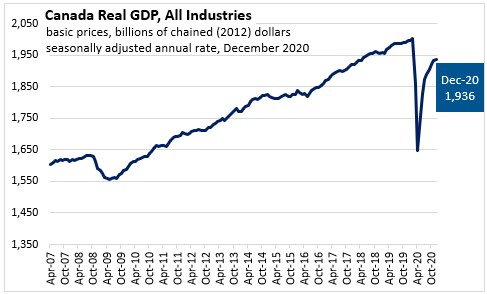The Economics and Statistics Division maintains archives of previous publications for accountability purposes, but makes no updates to keep these documents current with the latest data revisions from Statistics Canada. As a result, information in older documents may not be accurate. Please exercise caution when referring to older documents. For the latest information and historical data, please contact the individual listed to the right.
<--- Return to Archive
For additional information relating to this article, please contact:
March 02, 2021CANADA GDP BY INDUSTRY, DECEMBER AND ANNUAL 2020 Real Gross Domestic Product (GDP) in Canada edged up 0.1% in December following a 0.8% increase in the previous month. This was the eighth consecutive monthly real GDP gain in Canada. While the gains over the last eight months offset some of the losses observed in March and April 2020, total economic activity was 3.3% below the pre-pandemic level observed in February.
In December 2020, the Canadian economy is 3.0% smaller compared to December 2019 with an annualize value of $1,936 billion (chained 2012 dollars).
Statistics Canada’s preliminary estimate for real GDP points to an approximate 0.5% increase in January 2021. The official GDP data for January 2021 will be published on March 31, 2021.


Goods-Producing Industries
Goods-producing sector output increased 0.6% month-over-month in December 2020. Output in all sub-sectors except utilities and manufacturing were up in December 2020.
The mining, quarrying, and oil and gas extraction sector grew 2.9% in December with all three sub-sectors posting an increase in their activity. With higher international demand in last two months of the year, all types of mining and quarrying activities increased in December resulting in 3.6% growth in the mining and quarrying (except oil and gas) sector’s output.
Oil and gas extraction activity was up 2.5% in December posting the fourth consecutive monthly gain. Due to higher synthetic oil production in Alberta, oil sands extraction increased 4.0%.
Construction GDP increased 1.2% in December. Residential construction increased 1.4% in December. The gains in repair activities (+1.5%) and engineering and other construction activities (+1.4%) were partially offset by the decline in non-residential construction (-0.3%).
Agriculture, forestry, fishing and hunting output increased 1.1% in December led by higher crop production and forestry and logging.
The manufacturing sector output decreased 1.1% in December following a 1.5% increase in the previous month. December’s loss was primarily a result of lower sales and lower inventory formation and brought the sector’s output level to within 4.1% of its pre-pandemic level of activity.
Non-durable manufacturing output decreased 1.6% in December. The decline was led by Plastic and rubber products (-9.4%), petroleum and coal products (-4.4%), and chemical manufacturing (-1.6%) while food manufacturing (+2.1%) and paper manufacturing (+1.9%) partially offset the declines. Durable manufacturing output decreased 0.6%, led by machinery (-3.6%), fabricated metal products (-2.7%) and primary metal manufacturing (-3.8%).
Utilities sector’s output was unchanged in December. Statistics Canada noted that an increase in electric power generation, transmission, and distribution (+0.3%) was offset by lower natural gas distribution (-1.8%).
Services-Producing Industries
Output of services-producing sector edged down 0.1% in December 2020.
Activity in accommodation and food services declined 6.8% in December on renewed COVID-19 related lockdowns and additional travel restrictions. Food services and drinking places declined 6.7% and accommodation services declined 7.1%.
Retail trade sector’s output decreased 3.3% in December on renewed COVID-19 related lockdowns and restrictions. Activity declined the most in clothing and clothing accessories (-13.6%), general merchandise (-6.2%), sporting goods, hobby, book and music (-19.9%), and electronic and appliance stores (-10.3%).
Wholesale trade sector GDP decreased 1.2% in December posting the only second monthly decline since April 2020. Machinery, equipment and supplies wholesaling (-2.6%) led the decline as the majority of industries recorded losses. Motor vehicle and motor vehicle parts and accessories wholesaling activity declined 3.1% due to lower production and international trade of passenger cars, light trucks, and motor vehicle parts.
Activity in finance and insurance sector edged down 0.1% in December led by financial investment services, funds and other financial vehicles (-2.0%).
Activity at the offices of real estate agents and brokers increased 8.5% in December, an increase in December activity offset the decline in previous two months on strong home resale activity nationwide.
The public sector (educational services, health care and social assistance, and public administration) grew 0.6% this month with higher activity in all of the three components. Health care services increased 0.8% while education was up 0.6%. Public administration output increased 0.5% in December.
Transportation and warehousing increased by 0.7% with gains in all subsectors except water transportation (-1.3%).

Annual (2020 vs 2019)
The Canadian economy in 2020 declined 5.3% compared to 2019.
Amid the COVID-19 pandemic and economic recovery, the largest declines in activity have been in arts, entertainment and recreation (-41.2%), accommodation and food services (-33.4%) and transportation and warehousing (-19.8%). Agriculture, forestry, fishing and hunting (+4.7%), finance and insurance (+3.8%), and real estate and rental and leasing (+1.7%) have grown in 2020 over last year.

Source: Statistics Canada, Table 36-10-0434-01 Gross domestic product (GDP) at basic prices, by industry, monthly (x 1,000,000)
<--- Return to Archive